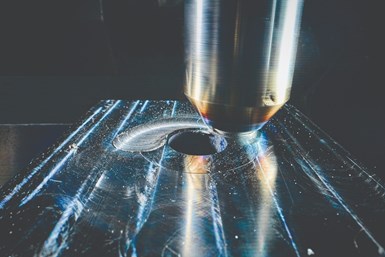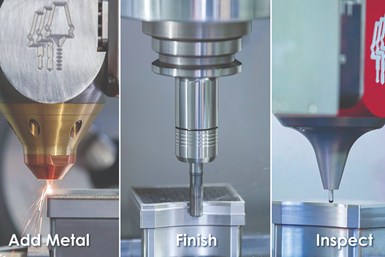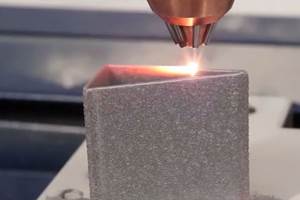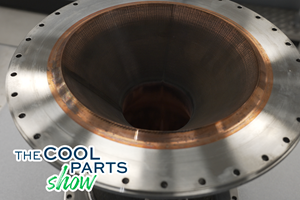Hybrid Manufacturing Turns Design Inside Out
Hybrid systems combine traditional subtractive processes with additional processes, including laser metal deposition for additive manufacturing and friction stir welding, enabling manufacturers to design products from the inside-out.

A rotating FSW tool plunges into the workpiece, dwells momentarily to enable rotation, friction and pressure to create a plasticized material pool, then traverses the workpiece to create the weld. Photo Credit: Mazak
Traditional manufacturing starts with a solid block of metal. Manufacturers think about how to mill, turn, grind and polish the part, move the part to the next manufacturing step, create subassemblies and bring parts together. Each activity occurs in distinct processing areas. Hybrid manufacturing disrupts that workflow.
Hybrid systems combine traditional subtractive processes with additional processes, including laser metal deposition (LMD) for additive manufacturing (AM) and friction stir welding (FSW). “Instead of designing products from outside-in, we can design from the inside-out, such as by sealing seam and then milling features. That’s really a paradigm shift in the way engineers think,” says Dale Fleck, general manager, Mazak MegaStir (IMTS booth: 338300).
Instead of using a stand-alone FSW system, which may have lower utilization rates, Mazak offers an alternative with its VTC-300c hybrid system, which offers everything users expect from a three-axis CNC, except that its powerful, 40-taper spindle also accepts FSW tools. Instead of multiple workstations, some parts can be “done in one.” This removes the time and labor associated with moving parts between machining and welding stations. It also removes potential sources of error, such as losing zero due to refixturing.
Super Multitasking
“Adoption of hybrid systems will accelerate when large manufacturers design parts that require internal structures,” says Jim Kosmala, vice president of engineering and technology, Okuma (IMTS booth: 338500). “That will inevitably occur because mechanical engineers understand the strength, weight and performance benefits of additive designs.”
The company’s MU-8000V Laser EX “super multitasking” CNC machine combines five-axis subtractive capabilities with LMD technology for AM, hardening and coating of workpiece blanks. By implementing LMD instead of laser metal fusion (LMF), this machine offers midprocess part inspection and material exchange, coolant use in work envelope, higher deposition rates and three-dimensional fabricating. A 4 kW Trumpf laser can supply power to up to four Laser EX machines.(Trumpf IMTS booth: 236217 and 433037)
More Revenue Streams

HMT has expanded the concept of “done-on-one machine” with product offerings that include metal and polymer AM, melt pool monitoring, inspection and more. Photo Credit: HMT
“Adding hybrid capabilities in-house opens up new revenue streams for mainstream manufacturers and job shops alike by giving them the power to control all steps of the production process,” says Lisa Block, director of global sales and marketing for Hybrid Manufacturing Technologies (HMT, IMTS booth: 432432). “Applications include repair, remanufacturer and feature enhancement. Our patented Ambit deposition heads extend part life cycle by adding layers of high-performance materials such as Inconel and stainless steel.”
HMT has proven its hybrid technology with industry leaders such as Mazak, Romi, Mitsui Seiki, Sugino and Tongtai. Originally, the company debuted the Ambit Flex platform for LMD designed to fit into a standard (CAT 40, HSK, etc.) toolholder for easy integration. In the subsequent years, HMT has released a vast array of product offerings, including but not limited to melt pool monitoring, various modes of inspection and polymer extrusion — all of which can be custom designed to fit any CNC, robot or gantry — further expanding the “done-on-one machine” concept.
To find how hybrid technology can bring more innovation to your manufacturing environment, register for IMTS 2022 and book your hotel now. IMTS 2022 runs Sept. 12-17, at Chicago’s McCormick Place.
Related Content
The Cold Spray Solution to the Casting, Forging Supply Chains
Startup HAMR Industries performs additive manufacturing work at Neighborhood 91 that provides an alternative to traditional casting and forging. Success so far has led to redefining the limits of its additive equipment.
Read MoreInfrared Camera Supports Real-Time Process Control for Laser Metal Deposition and Cladding
New Infrared Technologies’ Clamir system provides continuous meltpool monitoring for cladding and directed energy deposition 3D printing.
Read MoreArcelorMittal Enters Additive Manufacturing Industry With Steel Powder
The company is building an industrial-scale atomizer in Spain to produce high-quality steel powders for multiple additive manufacturing technologies.
Read More3D Printed NASA Thrust Chamber Assembly Combines Two Metal Processes: The Cool Parts Show #71
Laser powder bed fusion and directed energy deposition combine for an integrated multi-metal rocket propulsion system that will save cost and time for NASA. The Cool Parts Show visits NASA’s Marshall Space Flight Center.
Read MoreRead Next
To Improve Performance of Compression Molded Composites, Add 3D Printed Preforms
9T Labs' Additive Fusion Technology enables the manufacture of composite structures with as much or as little reinforcement as is necessary, using 3D printed continuous fiber preforms to add strength just where needed.
Read MoreVideo: Intelligent Layering Metal 3D Printing at 3DEO
Contract manufacturer 3DEO delivers metal parts using Intelligent Layering, a binder jetting-like 3D printing process the company developed and operates internally. Here’s how it works.
Read MoreLooking to Secure the Supply Chain for Castings? Don't Overlook 3D Printed Sand Cores and Molds
Concerns about casting lead times and costs have many OEMs looking to 3D print parts directly in metal. But don’t overlook the advantages of 3D printed sand cores and molds applied for conventional metal casting, says Humtown leader.
Read More












.png;maxWidth=300;quality=90)










